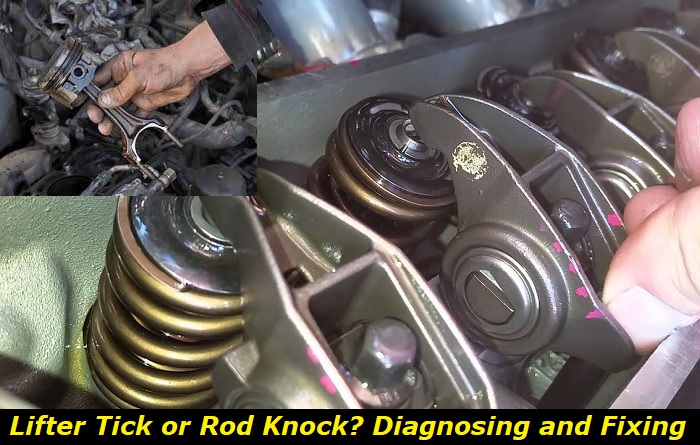Engine problems can be a nightmare, especially with the possible expensive repairs that come to mind once you experience them. In this article, we'll look at two engine issues: engine knock and lifter tick, and how to differentiate them in terms of their definition, diagnosis, how to fix them, and their consequences. But first, let's look at how a connecting rod and hydraulic lifter work.
Lifter problems highlights
- Level of importance:Medium
- Commonreasons:Age, poor oil, too high oil viscosity, mileage
- DIY inspection:Almost impossible
- DIY repair:Possible but very complicated
- Price for repair:$450 - $1,200
- Can you drive?Usually, yes
- Ways to fix:In most cases, replacing the lifters will be the only proper choice

The Function of Connecting Rod and Hydraulic Lifter
To fully understand what rod knock and lifter tick are, let's look at each function in the engine. The connecting rod is an engine part that connects the piston to the crankshaft. There's a bearing at the point where the connecting rod joins the crankshaft. This bearing function is to separate the rod from the crank journal. It's manufactured with a softer material than a crankshaft and connecting rod.
Gap tolerances exist where the connecting rod is in contact with the crankshaft journal. These gap tolerances allow oil to pass through the crankshaft journals holes and into the bearing's surface. The oil film prevents friction when the two parts rub against each other while the engine runs. Improper oil film can develop if the gap opens up too much, causing bearings to spin out of place, and making the rod rub against the crankshaft. This is what's referred to as rod knock and can be a result of wear and tear.
Hydraulic Lifter, on the other hand, are mechanical components in the internal combustion engine that help sustain a zero-valve clearance. It's also referred to as a hydraulic tappet, lash adjuster, or solid lifter. A small clearance is required between the head valve and rocker arms(a small rod in the cylinder head)) to prevent the two parts from binding as they expand due to the high temperatures of the engine.
Depending on the engine type, some lifters require adjusting to retain the small clearance, while others are maintenance-free. The lifters have small holes to allow oil to pass through to the spring and plunger to help them work seamlessly for quieter engine operation and zero valve clearance. The oil also prevents damage through wear and tear. If there's an issue with the oil, you'll likely hear a strange noise.
Now that you know how they function let's look at how to differentiate the sound of a rod knock and a lifter tick.
Difference between the Sound of a Rod Knock and a Lifter Tick
One of the telltale signs of a rod knock and lifter tick is the type of sound coming from the engine. A rod knock is a low-pitched knocking, banging, or rapping sound from deep within the engine. It sounds as if someone is banging metal on an iron door. The sound's intensity and frequency increase with the engine load and speed. The noise begins once you start the engine, at engine idling, and subsides once the car is turned off. If the sound disappears once the engine warms up, it's not a rod knock but a symptom of something else.
In contrast, a lifter tick is a ticking or tapping sound from the engine bay. Like an engine knock, the sound's rhythm, frequency, and volume can increase with stepping on the gas. Higher Rotations per Minute(RPMs) translate to louder tappings.
Causes of a Rod Knock and Lifter Tick
There are a variety of reasons that can cause a rod knock or lifter tick engine problems. Let's start with the causes of a rod knock.
Causes of a Rod Knock:
- Lean Air-Fuel Mixtures
A lean air-fuel mixture is one of the causes of a rod knock. It's a sign of too much air and not enough fuel. This can result from a faulty oxygen sensor, a defective fuel pump, or a bad mass airflow sensor.
- Bad Belt Pulleys
A rod knock noise may also result from a bad belt tensioner or pulley. The belt is connected to a series of pulleys and turns as the engine rotates. If It's tight and is pulled right, it works smoothly without any noise. However, a lack of enough tension on the accessory belt can lead to a rattling or knocking sound.
- Poor Engine Timing
Bad timing (the point at which the spark plug fires that the ECU controls) can also lead to a rod knock. Poor timing causes the spark plug not to fire when it should. That causes a detonation knock.
- Low Engine Oil Level
An irregular oil change causes a low oil level. Over time, the oil loses lubricating properties, viscosity rating, and density as the oil continues to flow in the engine. Lack of oil change can lead to sludge accumulation and corrosion. A drop in oil pressure due to a lack of enough oil can also cause premature damage to engine parts due to wear and tear. This causes a knocking sound.
Causes of Lifter Tick:
- A faulty hydraulic lifter
A bad lifter can cause you to hear a ticking sound. With the continuous intense pressure that the lifter undergoes, it's bound to fail after a while. It can also get damaged as a result of poor maintenance.
- A low Engine Oil Level
Lack of enough engine oil can damage many engine parts if the issue is not addressed. This includes the lifter. Its damage can result in a lifter tick.
- Contaminated Oil
Dirty engine oil can also be a reason behind the lifter's tick. The oil needs constant replacement, and failure to do so accumulates grime and dust, leading to a sludge buildup. The sludge eventually clogs up the valve lifter, hindering it from receiving the right lubrication to prevent its wear and tear.
- Oil with the Wrong Viscosity
As the engine varies between manufacturers, so do valve lifters and the recommended engine oils. Using too thick or too thin of oil and not using the recommended oil grade can negatively affect your valve lifter.
Diagnosis
You also have to make the right diagnosis to differentiate between a rod knock and a lifter tick. Let's cover how to make a diagnosis for each.
Below are some tried and tested methods to diagnose a rod knock.
- Pull out the engine oil dipstick.
- Wipe it with a rag
- Inspect the color of the dipstick. A dark brown color indicates that the oil is contaminated.
- Put the dipstick back in its place and remove it to confirm the color and viscosity of the oil. A too-thin oil or dirty oil needs replacement.
- Inspect the cod rod bearing after removing the crankcase. Check for signs of a loose connecting rod cap that may be causing the noise.
- Check if there's a leakage in the fuel pathway and if the bearings are fitted properly.
- A low-voltage test light, a timing light, and a stethoscope are tools that technicians use to diagnose a rod knock.
How to Diagnose a Lifter Tick
Apart from the loud knocking sound coming from the engine bay, here are other symptoms of a lifter tick.
Engine Misfires
A faulty lifter is one of the main reasons to cause an engine misfire. Once the lifter fails, the intake and exhaust valves don't open like they should, disrupting the combustion process.
Check Engine Light
One of the reasons the check engine light may come on is a faulty lifter. A check engine light illuminates when there's an electrical and mechanical parts malfunctioning.
How to Fix a Rod Knock and Lifter Tick
Issues of rod knock and lifter tick need fixing before the issue escalates and gets out of hand.
It's not advisable to continue driving your car if you have a rod knock. This is because the vehicle may fail to start at some point or even break down, and the engine blows up in the middle of nowhere.
Here are the ways to fix:
- One way to fix a rod knock is to clean the fuel injection system to remove the accumulated sludge using a fuel injector cleaner. Older cars with a carburetor need a carburetor cleaner instead.
- Replace the cod rod bearings if need be.
- Replace the engine oil. Drain it first by placing the catch pan under the draining plug and refilling the new oil with similar viscosity.
How to fix a Lifter Tick
Failing to fix a lifter tick can also lead to severe engine complications. Fixing the issue can have your engine running smoothly in no time.
Ways to Fix:
- Top up low-level oil and replace old and contaminated oil with new oil of the right grade.
- Add additives to the engine oil and components such as pushrods, valve lifters, and rocker's arms to keep them clean and ensure a smooth flow.
- Have a valve lifter replacement for broken valve lifters.
- Replace the oil filter to keep the oil clean and free from contamination.
- Replace rocker arms and pushrods.
Consequences of Not Fixing a Rod Knock and Lifter Tick
If the rod knock and the lifter tick go for long without fixing, they can lead to severe car engine complications that will end up blowing a hole in your budget trying to fix them.
Effects of Not Fixing a Rod Knock:
- Having to replace or rebuild an entire engine due to a complete engine failure.
- It may become destruction as you drive.
Effects of Not Fixing a lifter tick:
- It may cause damage to the camshaft.
- It can lead to damage to the catalytic converter.
- It may lead to an internal engine failure.
Bottom Line
There you go-Lifter tick vs. Rod knock. You can contact an experienced mechanic to help you make the right diagnosis and help you fix the issue.
About the authors
The CarAraC research team is composed of seasoned auto mechanics and automotive industry professionals, including individuals with advanced degrees and certifications in their field. Our team members boast prestigious credentials, reflecting their extensive knowledge and skills. These qualifications include: IMI: Institute of the Motor Industry, ASE-Certified Master Automobile Technicians; Coventry University, Graduate of MA in Automotive Journalism; Politecnico di Torino, Italy, MS Automotive Engineering; Ss. Cyril and Methodius University in Skopje, Mechanical University in Skopje; TOC Automotive College; DHA Suffa University, Department of Mechanical Engineering






Add comment